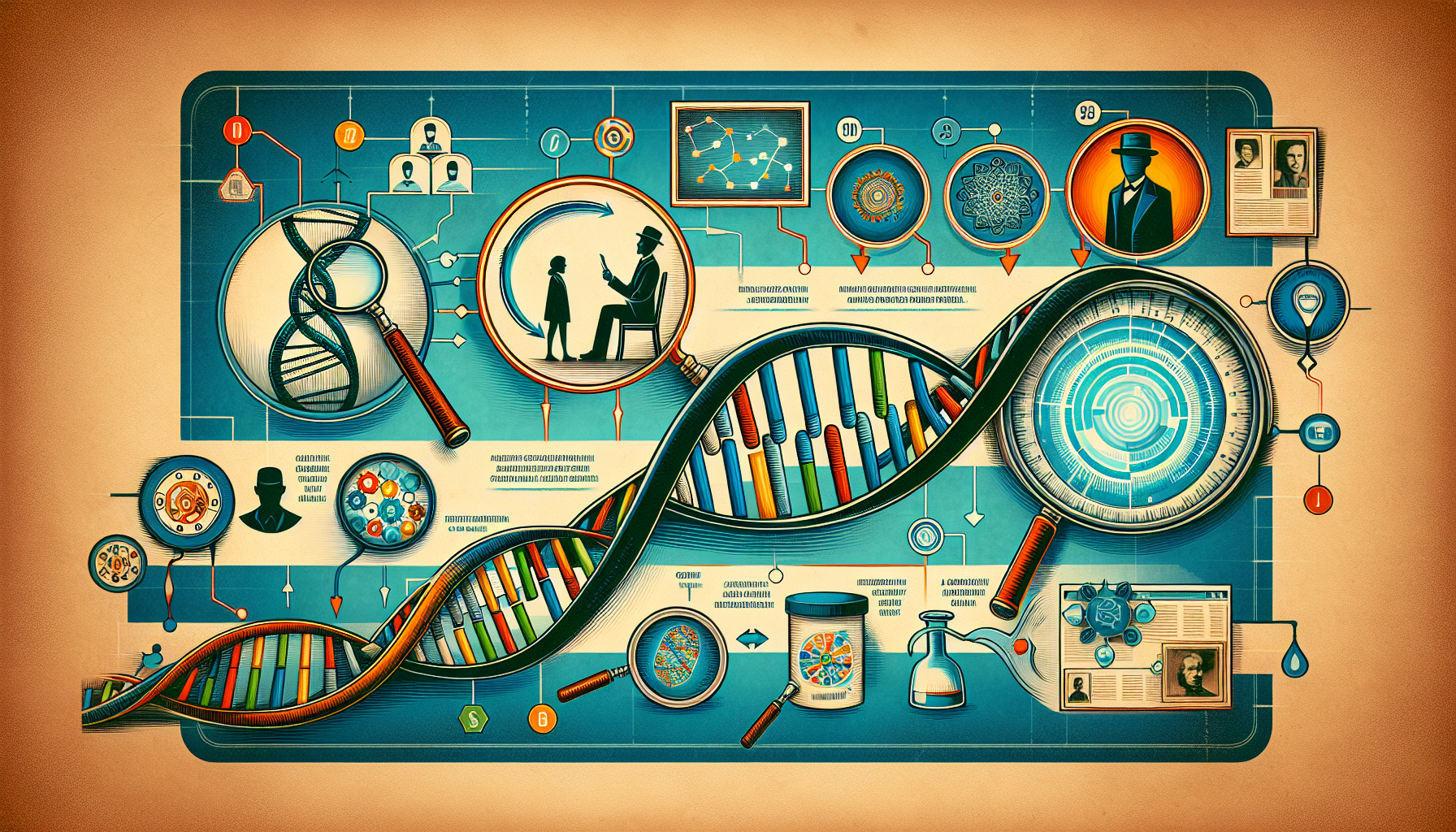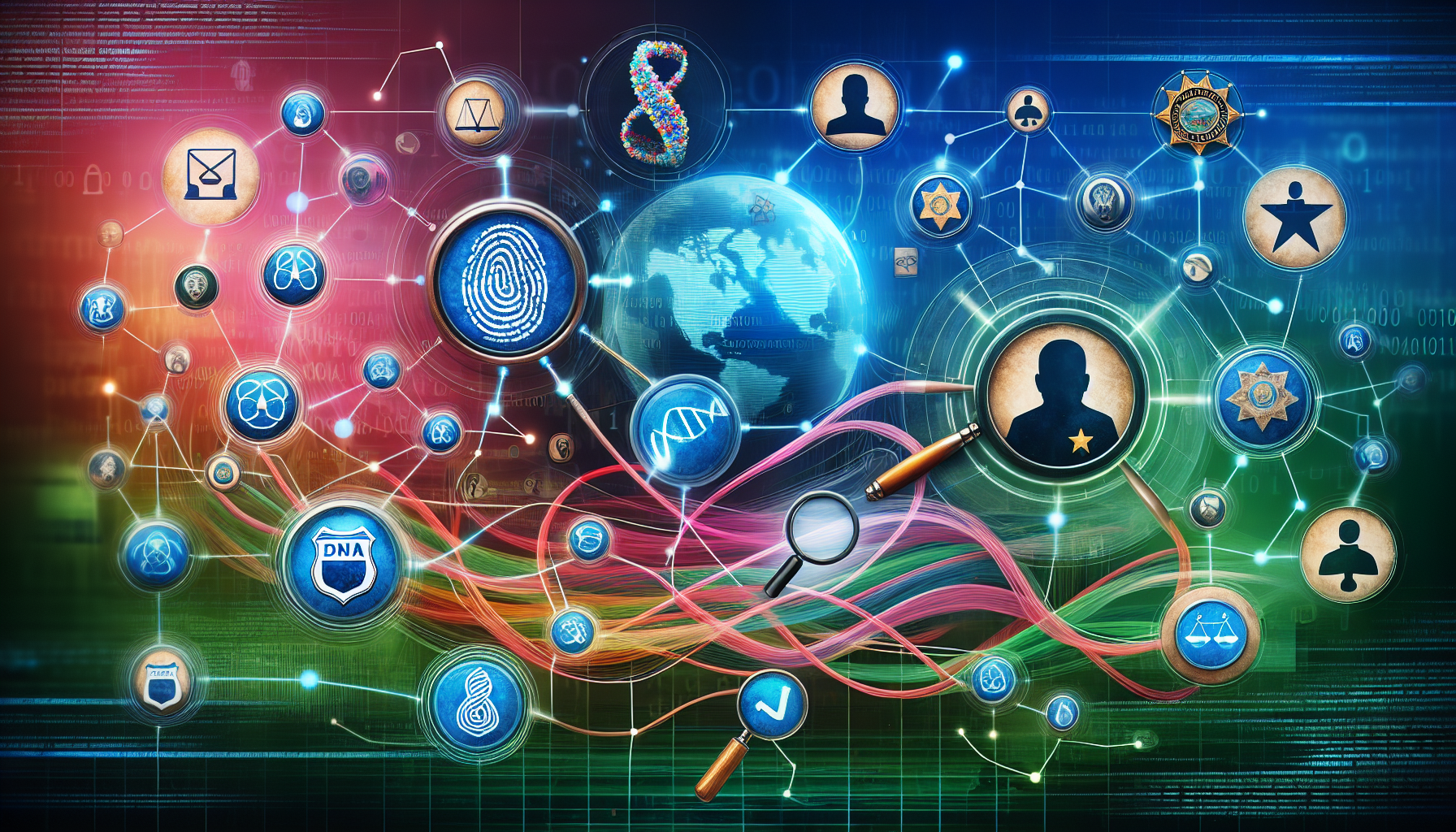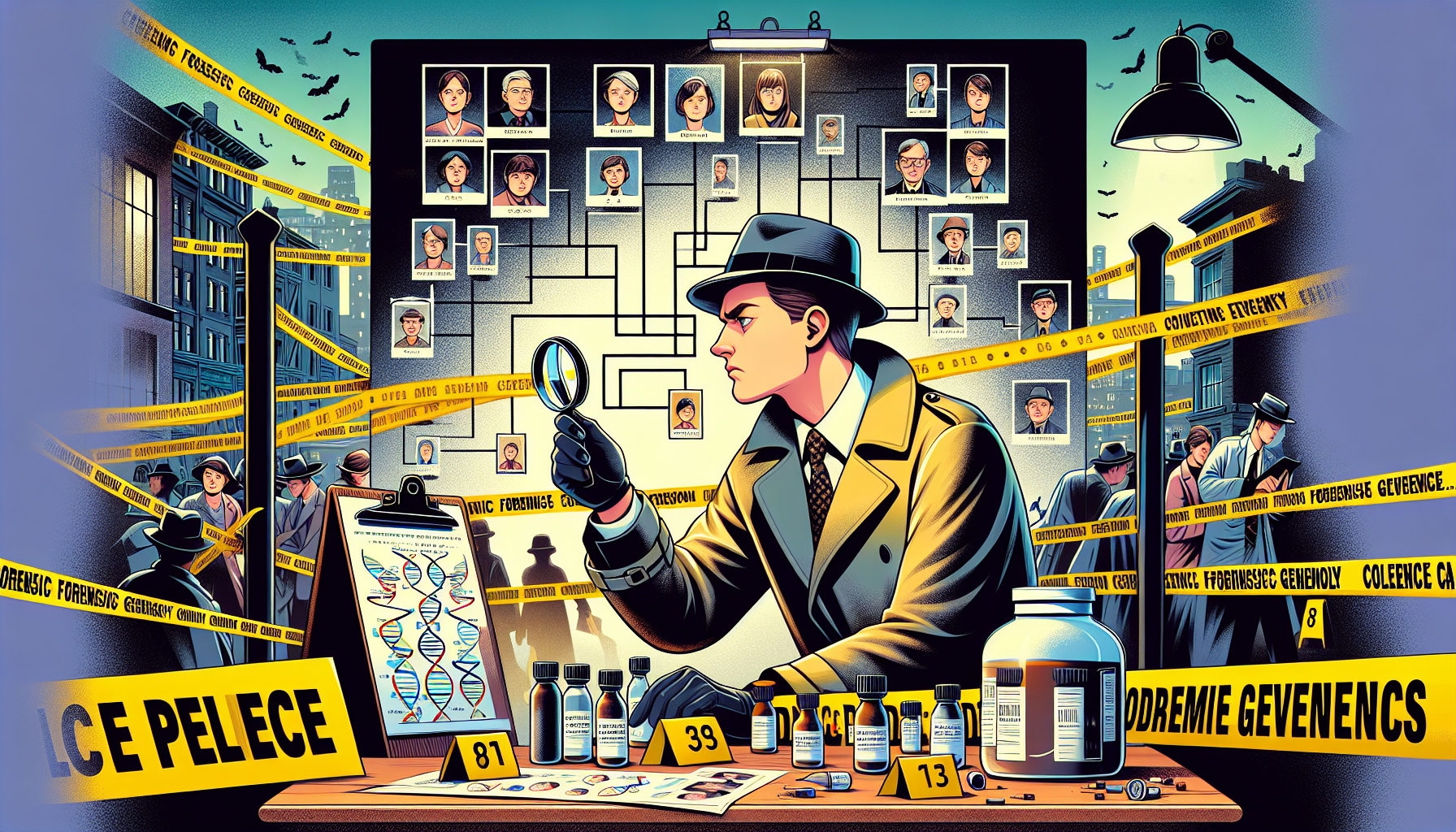Forensic genealogy uses DNA to solve crimes by identifying suspects through family connections. This article examines the evolution of this method, its techniques, and notable cases it has solved.
Key Takeaways
- Forensic genetic genealogy utilizes advanced genealogical techniques alongside traditional DNA profiling to address cold cases, enabling investigators to identify suspects through familial connections.
- The integration of public genetic databases, such as GEDmatch, with forensic DNA analysis has raised important ethical and privacy concerns, necessitating responsible use and clear consent protocols.
- Recent advancements in SNP analysis and machine learning are enhancing the accuracy and efficiency of forensic genetic genealogy, making it an increasingly vital tool for law enforcement in solving long-standing criminal cases.
The Evolution of Forensic Genealogy

Forensic genetic genealogy represents a significant evolution in the field of forensic science, fundamentally changing how investigators approach cold cases. It all started in the late 1990s with the creation of the Combined DNA Index System (CODIS), enabling law enforcement to match crime scene DNA profiles with known offenders. Yet, the system had its limitations, especially when there were no direct matches.
Forensic genetic genealogy has gained prominence, fueled by the public’s increasing interest in DNA and ancestry. Companies like 23andMe and AncestryDNA made genetic testing accessible to millions, creating vast databases of genetic information that could be used for more than just tracing family history. This surge in genetic data provided a new avenue for investigators to explore, especially when traditional forensic DNA profiling failed to yield results.
Investigative genetic genealogy takes advantage of this vast genetic information to identify suspects through familial relations. Comparing crime scene DNA with profiles in consumer genetic databases enables investigators to find potential relatives of unknown suspects, thereby significantly narrowing their search. This method has proven particularly effective in cases where there are no direct matches in CODIS, offering a new lifeline to cold cases that have long been unsolved.
Integrating forensic genetic genealogy into law enforcement has presented challenges, requiring a profound understanding of both forensic science and genealogical research, thereby creating a unique subdiscipline within forensic investigations.
Professional genealogists collaborate with law enforcement agencies, using their expertise to build accurate family trees and identify potential suspects. This partnership has led to numerous breakthroughs, showcasing the immense potential of this novel investigative tool.
Combining Forensic Science and Genealogical Research

Combining forensic science and genealogical research has revolutionized the approach to solving cold cases, creating a powerful synergy between two distinct fields. Forensic genetic genealogy merges traditional forensic DNA profiling with advanced genealogical techniques to identify suspects and victims. This integration has given rise to a new subdiscipline within forensic science, transforming how investigators tackle unsolved crimes.
When traditional methods fail to yield a match in the FBI’s CODIS database, forensic genetic genealogy becomes a crucial investigative tool. This approach involves generating a forensic DNA/STR profile and then conducting SNP testing to analyze genetic data. By comparing this data with profiles in public genetic genealogy databases, investigators can identify potential relatives of the unknown individual, providing new leads for the investigation.
Forensic genetic genealogy involves multiple steps, from analyzing DNA samples to constructing detailed family trees. Combining forensic evidence and genealogical research requires a meticulous approach, often involving professional genealogists and a forensic genealogist to ensure accuracy. Various companieshave become key players in this field, assisting law enforcement with genetic data analysis and suspect identification.
Machine learning is also starting to play a role in forensic genetic genealogy, enhancing the ability to analyze complex genetic data and identify potential matches. This technology promises to further improve the efficiency and accuracy of forensic investigations, making it an indispensable tool in the fight against crime.
DNA Analysis Techniques
Traditional forensic DNA profiling has long relied on Short Tandem Repeat (STR) analysis, focusing on specific DNA regions to create a unique genetic profile. Though effective, this technique has limitations, especially with degraded or compromised DNA samples. This is where forensic genetic genealogy offers a significant advantage, utilizing Single Nucleotide Polymorphisms (SNPs) to provide a more comprehensive analysis.
SNP testing analyzes between 600,000 to 1 million markers across the genome, providing a much higher resolution of genetic data compared to STR profiling. This detailed analysis allows for the identification of more distant relatives, expanding the pool of potential matches. Next Generation Sequencing (NGS) further enhances this capability, allowing for the analysis of even the most compromised DNA samples with high accuracy.
Specialized tools have been instrumental in advancing forensic genetic genealogy. Designed specifically for this application, these tools streamline the process of SNP testing and data analysis, making it easier for investigators to generate actionable leads. The integration of these advanced techniques has revolutionized cold case investigations, providing law enforcement with new methods to identify suspects and bring them to justice.
Building Family Trees from DNA Matches
At its core, forensic genetic genealogy constructs detailed family trees from DNA matches, requiring both scientific and genealogical expertise. Matching DNA samples to relatives allows investigators to narrow down the pool of potential suspects, often identifying individuals who would otherwise remain unknown. This approach has proven particularly effective in cases involving more distant relatives, where traditional forensic methods might fail.
Before:
Constructing family trees from genetic data is a meticulous process involving several key steps. First, investigators select DNA matches from genetic genealogy databases and confirm their identities using documentary evidence. This step is crucial for ensuring the accuracy of genealogical research, adhering to the Genealogical Proof Standard. Once identities are confirmed, the next step is to construct the family tree, tracing connections to identify potential suspects.
After:
Constructing family trees from genetic data involves several key steps:
- Select DNA matches from genetic genealogy databases.
- Confirm identities using documentary evidence, which is crucial for ensuring the accuracy of genealogical research and adhering to the Genealogical Proof Standard.
- Construct the family tree by tracing connections to identify potential suspects.
Detailed genealogical research is vital in this context. Professional genealogists play a crucial role, applying their expertise to build accurate family trees and uncover genetic connections that can solve cold cases. Their work often involves extensive family history research, examining records, and verifying relationships to ensure conclusions are credible and reliable, contributing to genealogical knowledge.
Public Genetic Genealogy Databases and Law Enforcement

The rise of direct-to-consumer genetic testing services such as 23andMe and AncestryDNA has dramatically expanded the pool of genetic data available for forensic investigations. These services have encouraged millions to explore their ancestry, leading to the creation of extensive genetic genealogy databases. Law enforcement agencies recognize the potential of these databases, utilizing them to find genetic matches that can provide new leads in criminal investigations.
Public genetic genealogy databases are crucial in forensic genetic genealogy, offering a wealth of genetic information to identify suspects and victims. Integrating these databases with traditional forensic DNA profiling has created a powerful tool for law enforcement, enabling them to solve long-cold cases. This section explores the use of these databases by law enforcement, focusing on the legal and ethical considerations involved.
A key ethical consideration is balancing privacy and public safety. While the Fourth Amendment may not protect genealogy searches, as users voluntarily upload their data to public databases, significant privacy implications remain. Using genetic data responsibly and ethically is crucial to maintaining public trust in forensic genetic genealogy.
The collaboration between forensic genealogists and law enforcement agencies has become more formalized, with professional standards and guidelines governing the use of genetic data in criminal investigations. This partnership has led to numerous breakthroughs, demonstrating the effectiveness of forensic genetic genealogy in solving cold cases and bringing justice to victims.
GEDmatch and Other Databases
GEDmatch is a significant public genetic genealogy database, allowing law enforcement access to uploaded genetic data under specific legal standards. This database played a crucial role in solving the Golden State Killer case, highlighting its importance in forensic genetic genealogy. GEDmatch PRO, a version designed for law enforcement use, has additional restrictions to ensure compliance with legal and ethical standards.
Other major genetic genealogy databases include FamilyTreeDNA, 23andMe, AncestryDNA, and MyHeritage DNA. These platforms allow users to upload their SNP data files, making them accessible for forensic genealogy purposes. FamilyTreeDNA, in particular, has been proactive in collaborating with law enforcement, providing a valuable resource for solving cold cases.
Collaboration between forensic genealogists and law enforcement has become more structured, with formal agreements and guidelines governing the use of genetic data. This partnership ensures responsible and ethical use of data, maintaining the integrity of forensic investigations. Professional genealogists provide the expertise needed to analyze genetic data and build accurate family trees, playing a crucial role in this process.
Privacy Implications
Law enforcement’s use of public genetic genealogy databases raises significant privacy implications, particularly regarding user consent and potential misuse of genetic data. Many users of genealogy services may not fully understand that law enforcement can access their genetic information for investigative purposes. This lack of understanding highlights the need for clear and specific consent when using genetic data for criminal investigations.
Ethical concerns also arise from the potential for genetic data to implicate innocent relatives in criminal investigations. Misinterpretation or misuse of DNA evidence can lead to wrongful implications, raising questions about the fairness and justice of forensic genetic genealogy. Additionally, there are concerns about the risk of genetic discrimination, particularly in employment and insurance contexts.
Regulatory frameworks are evolving to address these privacy concerns, with ongoing discussions about the ethical use of genetic data in law enforcement. Informed consent, privacy, and justice remain central topics in these debates, emphasizing the need for transparency and accountability.
Case Studies: Solving Cold Cases with Forensic Genealogy

Forensic genetic genealogy’s success in solving cold cases has been remarkable, providing new hope to victims and their families. One notable case is the Golden State Killer, where authorities used both traditional and genealogical methods to identify the suspect based on familial connections. The Golden State Killer, responsible for numerous violent crimes, remained unidentified for over four decades until DNA from crime scenes matched genealogical database profiles.
GEDmatch, a public genealogical database, played a crucial role in solving this case by allowing law enforcement to search for familial DNA matches. After constructing a family tree from DNA matches, investigators identified the suspect, Joseph James DeAngelo, through discarded DNA samples. This case highlighted the effectiveness of forensic genetic genealogy and brought widespread recognition to the potential of this novel investigative tool.
Another significant case solved using forensic genetic genealogy was the identification of the ‘Buckskin Girl’ in 2018, a cold case unsolved for over three decades. Through meticulous genealogical research and DNA analysis, investigators identified the victim, providing closure to her family. This success demonstrated the power of forensic genetic genealogy in resolving missing persons cases and unidentified human remains.
The resolution of multiple cold cases through forensic genetic genealogy has underscored its value in modern criminal investigations. By providing new leads and uncovering critical genetic connections, this approach has proven to be a game-changer in the fight against crime. The impact of these successes has been profound, inspiring further advancements and applications of forensic genetic genealogy in law enforcement.
Current Trends and Future Directions in Forensic Genealogy

Since its emergence in 2018, forensic genetic genealogy has grown significantly, driven by advancements in SNP analysis technologies and marker sets. This growth has been fueled by the increasing availability of genetic data through consumer DNA testing services and the integration of these databases into forensic investigations. The rapid adoption of forensic genetic genealogy by law enforcement agencies has also played a crucial role in its expansion.
Emerging technologies are enhancing the accuracy and efficiency of forensic genealogical research. Next Generation Sequencing (NGS) and machine learning algorithms are being used to analyze complex genetic data, providing more precise matches and new investigative leads. These advancements are enabling forensic genealogists to solve cold cases more quickly and accurately, further establishing forensic genetic genealogy as a vital tool in criminal investigations.
Transparency in how genetic data is used by law enforcement is critical to addressing public concerns and enhancing accountability. Efforts to improve transparency and establish formal standards in forensic genealogy practices are essential to maintaining public trust and ensuring ethical use of genetic data. Maryland became the first US state to regulate the use of consumer genetic data by law enforcement, setting a precedent for other states to follow.
The future of forensic genetic genealogy looks promising, with continued advancements in technology and growing recognition of its potential to solve cold cases. As the field evolves, ongoing efforts to address ethical issues and establish professional standards will be crucial in guiding its development. The potential for forensic genetic genealogy to revolutionize criminal investigations and bring justice to victims is immense, making it an exciting area of study and practice.
Ethical Considerations and Professional Standards
The practice of forensic genetic genealogy is governed by a set of professional standards, including the Genealogy Standards and the Genealogical Proof Standard of the Board for Certification of Genealogists (BCG). These standards ensure that genealogical research is conducted with accuracy, integrity, and respect for privacy. Adherence to these standards is crucial for maintaining the credibility and reliability of forensic investigations.
Ethical concerns arise with the use of public genetic databases by law enforcement, particularly regarding privacy implications and user consent. Many users may not fully understand that their genetic information can be accessed for investigative purposes, raising questions about informed consent and the potential for misuse of genetic data. There are also concerns about genetic discrimination, particularly in employment and insurance contexts, which need to be addressed through robust regulatory frameworks.
Continuous training for forensic genetic genealogy investigators is essential to keep them updated on new tools, methods, and ethical practices. This training ensures that investigators can apply the latest techniques while adhering to professional standards and ethical guidelines. By maintaining high standards of practice, forensic genetic genealogy can continue to be a powerful and responsible tool in the pursuit of justice.
Summary
Forensic genetic genealogy has transformed the landscape of criminal investigations, offering a novel and powerful tool to solve cold cases. By combining forensic science with genealogical research, this approach has provided new leads and identified suspects in cases that had long gone unsolved. The evolution of forensic genetic genealogy, driven by advancements in technology and the availability of genetic data, has opened up new possibilities for law enforcement.
Throughout this article, we have explored the techniques used in forensic genetic genealogy, the role of public genetic genealogy databases, and the ethical considerations that shape this field. We have also highlighted the successes of forensic genetic genealogy in solving high-profile cold cases, demonstrating its effectiveness and potential to bring justice to victims and their families.
As forensic genetic genealogy continues to evolve, the importance of transparency, ethical practices, and professional standards cannot be overstated. By addressing these issues and embracing emerging technologies, forensic genetic genealogy will continue to be a transformative force in criminal investigations. The future of this field is bright, promising new breakthroughs and the potential to solve even the most challenging cases.
Frequently Asked Questions
What is forensic genetic genealogy?
Forensic genetic genealogy is a powerful technique that merges forensic science with genealogical research, allowing investigators to identify suspects and victims by analyzing genetic data to trace familial relationships. This method has proven effective in solving cold cases and enhancing criminal investigations.
How does forensic genetic genealogy differ from traditional forensic DNA profiling?
Forensic genetic genealogy differs from traditional forensic DNA profiling by using Single Nucleotide Polymorphisms (SNPs) to analyze a wider array of genetic markers, facilitating the construction of family trees, as opposed to the unique genetic profiles created through Short Tandem Repeat (STR) analysis in traditional methods.
What role do public genetic genealogy databases play in forensic investigations?
Public genetic genealogy databases play a crucial role in forensic investigations by offering valuable genetic information that law enforcement can utilize to identify potential relatives of unknown suspects, thus generating new leads in criminal cases.
What are the ethical concerns associated with forensic genetic genealogy?
Ethical concerns associated with forensic genetic genealogy primarily involve privacy implications, informed consent, genetic discrimination, and the potential misuse of genetic data. It is essential to establish regulatory frameworks and professional standards to ensure responsible practices in this field.
Can forensic genetic genealogy solve any cold case?
Forensic genetic genealogy can significantly aid in solving cold cases, but its effectiveness relies on the availability of genetic data and the capability to construct accurate family trees. Thus, while promising, it is not a universal solution for all cold cases.





